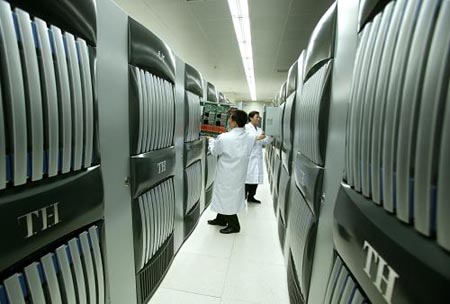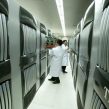
China Eyes “Dual Use” Applications for its Supercomputers
Publication: China Brief Volume: 10 Issue: 23
By:

As of November 15, the world’s fastest supercomputer officially belongs to China, according to the most recent listing of the world’s Top 500 computers [1]. China has pushed the United States out of the top spot as well as putting a third machine into the top ten, providing another indicator of China’s rise as a world technological power. Yet this year’s results should come as a surprise to no one. China has been pouring investments into high performance computing for the last decade and gradually edging the United States out of the top ten. Increased funding and an official policy commitment have propelled China from a technological backwater that in 2001 did not have a single machine in the Top 500 into a supercomputing superpower [2].
Supercomputers, or high-performance computers, are an enabling technology that opens up a wide range of research frontiers previously closed to Chinese institutions, not least in defense applications. They are an increasingly important tool in intelligence as well as weapons design, and a crucial link in any national innovation chain. China emphasizes the civilian applications of its supercomputers [3], but a quick glance at China’s history and R&D architecture would indicate that they will see significant military use. At the same time, while China’s triumph in supercomputing is a milestone, it should not be seen as a signal that China has exceeded the innovative power of the West, but rather as a launch pad for further technological development.
A Dual-Use Technology
By devoting national R&D resources to developing domestic supercomputing capabilities, the Chinese government is betting on a return on its investment in the form of heightened R&D capabilities in a wide range of fields. Heightened commercial and civilian research capabilities are certainly among the payoffs of building such a powerful computer, but China’s military will certainly benefit greatly as well [4].
Supercomputers can be put to work on one complex problem or multiple decentralized ones, but it stands to reason that they are usually employed for issues that require the quadrillions of calculations per second that they are capable of. The complex mathematical analysis involved in cryptanalysis and sensor signal processing today are problems that can only be tackled practically by computers with these “super” capabilities. China’s efforts to develop a secure satellite communications network as well as data fusion systems for missile tracking are critically dependent on a capability to process encrypted data at a very high rate of calculations per second.
While China’s newest and fastest supercomputer is ostensibly for civilian research [5], it is highly significant that it was built by the National University of Defense Technology (NUDT), China’s premier military technology university and one of its top research centers. The bulk of the world’s supercomputer processing power and most likely China’s as well is devoted to commercial and academic research, but any modernizing military like China’s also has an increasing need for supercomputing capabilities. In the 1990s China was accused of diverting supposedly civilian supercomputers purchased from the United States for military ends [6], so it would not be the first time China used the fig leaf of “civilian usage” to mask military supercomputing programs. At NUDT, supercomputer development labs like the National Key Lab for Parallel and Distributed Processing operate on the same campus as the respective National Key Labs for C4ISR and Automatic Target Recognition [7]. These are the very same kinds of research facilities that would be expected to have need for supercomputers to support their work.
Additionally, supercomputers provide indispensible services for a nation in the process of modernizing its nuclear and conventional armament. Since all nuclear test explosions are precluded under the Comprehensive Nuclear Test Ban Treaty (CTBT), nuclear blast modeling can be performed only by large computers. Missile, jet engine, and conventional explosive design and modeling are also increasingly done using supercomputers. With a much improved supercomputer arsenal, China also has an increased capability for the R&D necessary to bring its armed forces into the 21st century.
China’s possession of supercomputer technology may also constitute a proliferation risk. As a result of their military applications and in particular their cryptanalytic functions, much of the technology in a supercomputer is defined as “dual-use” according to the Wassenaar Arrangement on Export Controls [8]. Supercomputers can be compared to any dual-use technology like a rocket engine or a nuclear reactor: they can be used for commercial civilian projects or they can be used to produce weapons. Since the PRC is the only major supercomputing power that is not a signatory of the Wassenaar Arrangement, there is an elevated risk that supercomputers could be sold to rogue states to assist their nuclear programs.
Popular Misperceptions
China now has the most powerful computer in the world, but that does not mean that their ability to innovate has eclipsed that of the United States, nor does it mean that China has a military or intelligence collection advantage. The ascent of the Chinese to the number one spot is based more upon political will to invest in technology than any significant indigenous technological breakthrough.
Building a more powerful computer is accomplished today by linking together an incrementally larger cluster of processors and writing software that allows them to operate together, rather than (in most cases) designing a new and groundbreaking computing technology. The cost to build a top supercomputer has also dropped precipitously in the past ten years, meaning that the Chinese had to invest a relatively smaller sum compared to the amount spent by U.S. institutions to develop top supercomputers just ten years ago.
This is not to say that China’s newest and most powerful supercomputer, the Tianhe-1A (which translates as “Milky Way”) is not innovative. It combines its CPUs with GPUs (graphics processing units) to increase performance, consumes significantly less energy than its peers in the United States [9], and possesses a Chinese-designed interconnect chip and software that links the cluster together. The system also contains 2048 Chinese-made Galaxy FT-1000 processors with an undisclosed purpose [10], likely as a memory controller/synchronizer to boost the speed of the system. The bulk of its hardware, however, is still designed by Intel and NVIDIA, which are both based in California. This means that while Chinese labs may be working hard to produce entirely indigenous supercomputer systems, they currently still rely on foreign imports.
Just having a faster machine does not in itself provide any advantage for Chinese researchers either. In some sense building the Tianhe-1A only provides China with a showy muscle car: it might be able to go from 0 to 60 mph in 3 seconds, but that doesn’t provide much added utility if the owner is only using it to drive to work. The real test of innovative ability will be in designing specific applications for the computer’s power so that it does not lie idle for most of the day. Building such a large cluster will also be a waste if it is used for decentralized or cloud computing instead of concentrating on a few very large and knotty problems, since smaller and cheaper computer systems could be used for easier tasks.
China’s supercomputer dominance cannot then be taken as a signal of U.S. technological inferiority. If U.S. researchers and policymakers are to take any lesson from the November 2010 Top 500 listing, it is that the playing field has been leveled. By investing heavily in high performance computing and making it a feature of the 11th 5-year Plan for Technology [11], Beijing has proved that it is serious about its goals for high performance computing and is willing to devote the necessary resources for research and development. China’s supercomputing research labs may not be superior to similar facilities in the United States, but they currently enjoy generous funding and directives from central planners to develop faster machines.
Now that China has demonstrated its commitment and ability to build faster machines, it seems likely that the United States will respond to the challenge. After Japan’s surprise coup for the fastest computer, which lasted from 2002-2004, the U.S. responded with an increase in research funding for supercomputer projects and managed to push Japan entirely out of the top ten by 2007 [12]. Today U.S. institutions have the capability to build faster machines, but according to Jack Dongarra, the computer scientist at Oak Ridge Labs and the University of Tennessee who oversees the judging of the Top 500, “it’s a question of will.” According to an October 2010 report by the National Center for Computational Sciences, two new supercomputers, each capable of more than 20 petaflops, are respectively under construction at Lawrence Livermore and Oak Ridge National Labs, but the systems will not be operational until 2012 and few details are available as to their systems [13].
Conclusions
This new wave of Chinese supercomputers has the potential to give Chinese research institutions a leg up on the United States in terms of future defense and commercial technological innovation, but the real test will be in software and applications that may still be in development. A fast computer is a trove of research potential, but if it lies untapped then the placement of a Chinese machine into the number one spot will be nothing more than flag-waving.
Nevertheless, Chinese defense technology research labs now have the means, motive, and opportunity to take advantage of high performance computing resources. China’s conventional and nuclear weapons design programs as well as its intelligence and signal processing architecture have already progressed to the stage where they can make efficient use of a growing supply of supercomputers. Access to machines like the Tianhe-1A thus opens up new horizons for Chinese defense researchers and cryptographers, and chips away at the technological and military advantages of the United States.
Observers will have to come to terms with the fact that this is not a fluke or a one-time effort to build a single machine and briefly upstage the Americans. While American computing labs may be able to recover their lead in a few years, this year’s display of Chinese supercomputing power is only the latest technology being churned out by Chinese research labs in a concerted push to become a leading global innovator.
Notes:
1. Top 500 Supercomputers: https://www.top500.org/.
2. See technological objectives in China’s 11th 5-year plan: https://english.gov.cn/2006-03/06/content_219817.htm.
3. List of National Supercomputing Center Applications: https://www.nscc-tj.gov.cn/list.asp?id=83.
4. The wide range of major supercomputer applications includes subjects as diverse as petroleum prospecting, neutron science, genetic modeling, astrophysics, climate change modeling, nuclear reactor design, nuclear blast modeling, advanced materials science, missile design, cryptanalysis, and encrypted signals processing.
5. List of National Supercomputing Center Applications: https://www.nscc-tj.gov.cn/list.asp?id=83.
6. “China and Supercomputers,” NTI publications, https://www.nti.org/db/china/supercom.htm.
7. NUDT Research & Development listings, https://english.nudt.edu.cn/sub_index.asp?classid=13&child=3&typeid=0
8. Wassenaar Agreement classifications, https://www.wassenaar.org/controllists/index.html. See Category 4: Computers.
9. “NVIDIA Tesla GPUs Power World’s Fastest Supercomputer,” NVIDIA press releases.
https://pressroom.nvidia.com/easyir/customrel.do?easyirid=A0D622CE9F579F09&version=live&prid=678988&releasejsp=release_157.
10. Hong Zhaofeng. “tianheyihao zueiniou! gaosingneng jisuan TOP1000 wu kandian.” IT-168,
https://server.it168.com/a2010/1028/1118/000001118977_all.shtml.
11. Technological objectives in China’s 11th 5-year plan https://english.gov.cn/2006-03/06/content_219817.htm.
12. Top 500 List Releases: https://www.top500.org/lists.
13. Patrick Thibodeau, “U.S. building next wave of supercomputers”. Computerworld, https://www.computerworld.com/s/article/9196378/U.S._building_next_wave_of_supercomputers_.





